Centuries of Tradition: Visiting Weavers from Mexico
Posted in People on June 9 2015, by Miriam Flores
Miriam Flores is an intern with the Exhibitions Program of The New York Botanical Garden.

During the opening weeks of FRIDA KAHLO: Art, Garden, Life, the Botanical Garden hosted two special guests from Mexico. Juana and Yolanda, sisters from the town of Zinacatán in the state of Chiapas, were showing off the ancient technique of weaving with the back strap loom and decorating cloth with beautiful embroidery. Wearing traditional garments that they made and adorned themselves, they caught the attention of many visitors.

The back strap loom, or telar de cintura, is an ancient technique for weaving fabrics of small and medium widths. It’s simple, easily transportable, and has not changed much over the centuries. It consists of two bars—one at the end of the loom that is attached to a fixed point (like a tree or post) and the other attached by a belt that goes around the weaver’s back. Leaning back against the belt, the weaver puts tension on the loom and adjusts tightness to her preference. This simple loom was used by the ancient Mayas and is still used today by people throughout Central and South America.
In pre-Hispanic Mexico, weaving took place in the home, where girls at a young age learned different weaving techniques and made natural dyes from insects. Yolanda learned to weave when she was only seven years old, as did her mother and grandmother, using the same simple loom. Each piece made by the weavers is unique and has a significant meaning. She spends between five and 10 hours to weave small pieces, while more complex designs can take up to 70 hours.

Life is not always easy for women living in the indigenous communities in the highlands of Mexico. Yolanda and Juana face many challenges. They lost their father at a young age and soon after began working, selling flowers and fruits. Thanks to the efforts of their mother, who was searching for ways to lift the family out of poverty, they joined a sustainable development program.
After several workshops, they began working with a non-profit organization where they improved their skills. They learned how to make better quality textiles as well as integrate embroidery styles and colors according to fashion trends. Another key skill learned was how to market their products. Thanks to the work of this organization, Proyecto Impacto Consultores, AC, they mastered the skill of weaving.
Since then, they have started an association called Mujeres sembrando la vida, where they coach and teach 200 women on more sophisticated weaving techniques and encourage women to participate in forums. Through the sale of their crafts, these women now have a new way to provide income for their families. This improves their lifestyle and gives their children access to education and health services.

Preserving this tradition has helped Juana and Yolanda master the art of weaving and embroidery. It has given them an opportunity to leave the streets of Zinacatán and become well-known in neighboring towns. It has also made it possible for them to travel internationally to show their work. They developed close friendships with customers who appreciate and value the quality of their products. Now, Juana and Yolanda are leaders in their community who teach and encourage other woman to follow the weaving tradition with dignity and pride. It was a great pleasure working with them and we hope to see them again soon. Hasta pronto, amigas!
We now look forward to working with Abigail and Miriam from Oaxaca, and telling their stories in turn. Please stop by Shop in the Garden now through June 14 to say hola!

